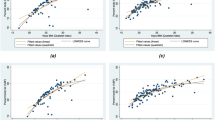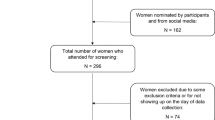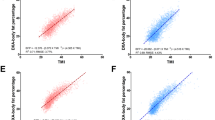Abstract
Background/objectives:
Bioelectrical impedance analysis (BIA) is used in population and clinical studies as a technique for estimating body composition. Because of significant under-representation in existing literature, we sought to develop and validate predictive equation(s) for BIA for studies in populations of African origin.
Subjects/methods:
Among five cohorts of the Modeling the Epidemiologic Transition Study, height, weight, waist circumference and body composition, using isotope dilution, were measured in 362 adults, ages 25–45 with mean body mass indexes ranging from 24 to 32. BIA measures of resistance and reactance were measured using tetrapolar placement of electrodes and the same model of analyzer across sites (BIA 101Q, RJL Systems). Multiple linear regression analysis was used to develop equations for predicting fat-free mass (FFM), as measured by isotope dilution; covariates included sex, age, waist, reactance and height2/resistance, along with dummy variables for each site. Developed equations were then tested in a validation sample; FFM predicted by previously published equations were tested in the total sample.
Results:
A site-combined equation and site-specific equations were developed. The mean differences between FFM (reference) and FFM predicted by the study-derived equations were between 0.4 and 0.6 kg (that is, 1% difference between the actual and predicted FFM), and the measured and predicted values were highly correlated. The site-combined equation performed slightly better than the site-specific equations and the previously published equations.
Conclusions:
Relatively small differences exist between BIA equations to estimate FFM, whether study-derived or published equations, although the site-combined equation performed slightly better than others. The study-derived equations provide an important tool for research in these understudied populations.
This is a preview of subscription content, access via your institution
Access options
Subscribe to this journal
Receive 12 print issues and online access
$259.00 per year
only $21.58 per issue
Buy this article
- Purchase on Springer Link
- Instant access to full article PDF
Prices may be subject to local taxes which are calculated during checkout

Similar content being viewed by others
References
NHLBI Obesity Education Initiative. Practical Guide to the Identification, Evaluation and Treatment of Overweight and Obesity in Adults. National Heart, Lung and Blood Institute. U.S. Department of Health and Human Services., NIH Publication Number: Washington, DC, USA, 2000, NIH Publication no. 02–4084.
Roche AF, Heymsfield SB, Lohman TG . Human Body Composition. Human Kinetics: Champaign, IL, USA, 1996, pp 25–78.
Lukaski HC, Bolonchuk WW, Hall CB, Siders WA . Validation of tetrapolar bioelectrical impedance method to assess human body composition. J Appl Physiol 1986; 60: 1327–1332.
Snijder MB, Kuyf BE, Deurenberg P . Effect of body build on the validity of predicted body fat from body mass index and bioelectrical impedance. Ann Nutr Metab 1999; 43: 277–285.
Leman CR, Adeyemo AA, Schoeller DA, Cooper RS, Luke A . Body composition of children in south-western Nigeria: validation of bio-electrical impedance analysis. Ann Trop Paediatr 2003; 23: 61–67.
Schoeller DA, Luke A . Bioelectrical impedance analysis prediction equations differ between African Americans and Caucasians, but it is not clear why. Ann N Y Acad Sci 2000; 904: 225–226.
Wells JC, Hawton K, Darch T, Lunn PG . Body composition by 2H dilution in Gambian infants: comparison with UK infants and evaluation of simple prediction methods. Br J Nutr 2009; 102: 1776–1782.
Buffa R, Floris G, Marini E . Assessment of nutritional status in free-living elderly individuals by bioelectrical impedance vector analysis. Nutrition 2009; 25: 3–5.
Hawkesworth S, Prentice AM, Fulford AJ, Moore SE . Dietary supplementation of rural Gambian women during pregnancy does not affect body composition in offspring at 11-17 years of age. J Nutr 2008; 138: 2468–2473.
Prins M, Hawkesworth S, Wright A, Fulford AJ, Jarjou LM, Prentice AM et al. Use of bioelectrical impedance analysis to assess body composition in rural Gambian children. Eur J Clin Nutr 2008; 62: 1065–1074.
VanderJagt DJ, Morales M, Thacher TD, Diaz M, Glew RH . Bioelectrical impedance analysis of the body composition of Nigerian children with calcium-deficiency rickets. J Trop Pediatr 2001; 47: 92–97.
Medoua GN, Nana ES, Essa'a VJ, Ntsama PM, Matchawe C, Rikong HA et al. Body composition of Cameroonian lactating women determined by anthropometry, bioelectrical impedance, and deuterium dilution. Nutrition 2011; 27: 414–419.
VanderJagt DJ, Trujillo MR, Jalo I, Bode-Thomas F, Glew RH, Agaba P . Pulmonary function correlates with body composition in Nigerian children and young adults with sickle cell disease. J Trop Pediatr 2008; 54: 87–93.
VanderJagt DJ, Okolo SN, Rabasa AI, Glew RH . Bioelectrical impedance analysis of the body composition of Nigerian children with sickle cell disease. J Trop Pediatr 2000; 46: 67–72.
Mutimura E, Anastos K, Zheng L, Cohen M, Binagwaho A, Kotler DP . Effect of HIV infection on body composition and fat distribution in Rwandan women. J Int Assoc Physicians AIDS Care (Chic) 2011; 9: 173–178.
Villamor E, Saathoff E, Mugusi F, Bosch RJ, Urassa W, Fawzi WW . Wasting and body composition of adults with pulmonary tuberculosis in relation to HIV-1 coinfection, socioeconomic status, and severity of tuberculosis. Eur J Clin Nutr 2006; 60: 163–171.
Papathakis PC, Rollins NC, Brown KH, Bennish ML, Van Loan MD . Comparison of isotope dilution with bioimpedance spectroscopy and anthropometry for assessment of body composition in asymptomatic HIV-infected and HIV-uninfected breastfeeding mothers. Am J Clin Nutr 2005; 82: 538–546.
Luke A, Bovet P, Forrester TE, Lambert EV, Plange-Rhule J, Schoeller DA et al. Protocol for the modeling the epidemiologic transition study: a longitudinal observational study of energy balance and change in body weight, diabetes and cardiovascular disease risk. BMC Public Health 2012; 11: 927.
Barro RJ, Lee JW . A New Data Set of Educational Attainment in the World, 1950–2010. The National Bureau of Economic Research, 2011.
Lukaski HC, Bolonchuk WW . Estimation of body fluid volumes using tetrapolar bioelectrical impedance measurements. Aviat Space Environ Med 1988; 59: 1163–1169.
Schoeller DA, van Santen E, Peterson DW, Dietz W, Jaspan J, Klein PD . Total body water measurement in humans with 18O and 2H labeled water. Am J Clin Nutr 1980; 33: 2686–2693.
Wang Z, Deurenberg P, Wang W, Pietrobelli A, Baumgartner RN, Heymsfield SB . Hydration of fat-free body mass: new physiological modeling approach. Am J Physiol 1999; 276 (6 Pt 1), E995–E1003.
Lin LI . A concordance correlation coefficient to evaluate reproducibility. Biometrics 1989; 45: 255–268.
Kushner RF, Schoeller DA, Fjeld CR, Danford L . Is the impedance index (ht2/R) significant in predicting total body water? Am J Clin Nutr 1992; 56: 835–839.
Kushner RF, Schoeller DA . Estimation of total body water by bioelectrical impedance analysis. Am J Clin Nutr 1986; 44: 417–424.
Luke A, Durazo-Arvizu R, Rotimi C, Prewitt TE, Forrester T, Wilks R et al. Relation between body mass index and body fat in black population samples from Nigeria, Jamaica, and the United States. Am J Epidemiol 1997; 145: 620–628.
Wang J, Thornton JC, Burastero S, Heymsfield SB, Pierson RN Jr . Bio-Impendance analysis for estimation of total body potassium, total body water, and fat-free mass in white, black and asian adults. Am J Hum Biol 1995; 7: 33–40.
Zillikens MC, Conway JM . Estimation of total body water by biolectrical impedance analysis in blacks. Am J Hum Biol 1991; 3: 25–32.
Lukaski HC, Johnson PE, Bolonchuk WW, Lykken GI . Assessment of fat-free mass using bioelectrical impedance measurements of the human body. Am J Clin Nutr 1985; 41: 810–817.
Segal KR, Burastero S, Chun A, Coronel P, Pierson RN Jr ., Wang J . Estimation of extracellular and total body water by multiple-frequency bioelectrical-impedance measurement. Am J Clin Nutr 1991; 54: 26–29.
Sun SS, Chumlea WC, Heymsfield SB, Lukaski HC, Schoeller D, Friedl K et al. Development of bioelectrical impedance analysis prediction equations for body composition with the use of a multicomponent model for use in epidemiologic surveys. Am J Clin Nutr 2003; 77: 331–340.
Van Loan MD, Mayclin P . Bioelectrical impedance analysis: is it a reliable estimator of lean body mass and total body water? Hum Biol 1987; 1987: 299–309.
Dioum A, Gartner A, Cisse AS, Delpeuch F, Maire B, Wade S et al. Validity of impedance-based equations for the prediction of total body water as measured by deuterium dilution in African women. Am J Clin Nutr 2005; 81: 597–604.
Acknowledgements
The authors acknowledge the site-specific clinical staff members as well as the 2500 participants. METS is funded in part by the National Institutes of Health (1R01DK80763).
Author information
Authors and Affiliations
Corresponding author
Ethics declarations
Competing interests
The authors declare no conflict of interest.
Rights and permissions
About this article
Cite this article
Luke, A., Bovet, P., Forrester, T. et al. Prediction of fat-free mass using bioelectrical impedance analysis in young adults from five populations of African origin. Eur J Clin Nutr 67, 956–960 (2013). https://doi.org/10.1038/ejcn.2013.123
Received:
Revised:
Accepted:
Published:
Issue Date:
DOI: https://doi.org/10.1038/ejcn.2013.123
Keywords
This article is cited by
-
The bioelectrical impedance analysis (BIA) international database: aims, scope, and call for data
European Journal of Clinical Nutrition (2023)
-
Independent association of resting energy expenditure with blood pressure: confirmation in populations of the African diaspora
BMC Cardiovascular Disorders (2018)
-
Gut microbiota, short chain fatty acids, and obesity across the epidemiologic transition: the METS-Microbiome study protocol
BMC Public Health (2018)
-
Cardiovascular risk status of Afro-origin populations across the spectrum of economic development: findings from the Modeling the Epidemiologic Transition Study
BMC Public Health (2017)
-
A comparison of indices of glucose metabolism in five black populations: data from modeling the epidemiologic transition study (METS)
BMC Public Health (2015)



